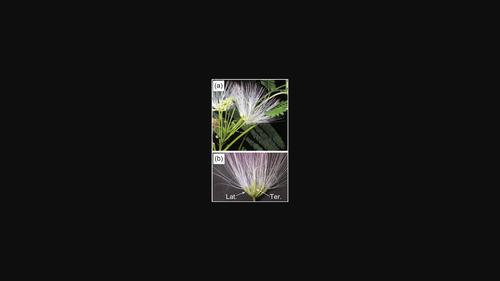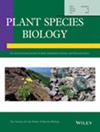Differences in reproductive function between terminal and lateral flowers in the capitulum of Albizia julibrissin (Fabaceae) based on female fertility, ovule number, and pistil and polyad size
IF 1.3
4区 生物学
Q4 ECOLOGY
引用次数: 0
Abstract
The division of labor between florets responsible for reproduction and special functions occurs widely in condensed inflorescences. The capitulum of Albizia julibrissin consists of approximately 10–20 lateral flowers and usually one nectar‐secreting terminal flower; the two flower types are morphologically distinct, but the differences in reproductive function have not been revealed. To determine the differences in reproductive function between terminal and lateral flowers, we compared the ratio of terminal and lateral flowers at the flowering and young pod stages. Additionally, ovule number, stigma size, polyad size, and the ratio of flower abscission were compared between the two flower types. Significant differences were detected only in female fertility between the two flower types. At the flowering stage, 6.8% of flowers were terminal flowers, whereas at the young pod stage, all young fruits were obtained from lateral flowers. At the final stage of blooming, based on the generalized linear model analysis, the ratio of surviving terminal flowers was lower than that of the lateral flowers in a capitulum. These results suggest that the terminal flowers of A. julibrissin had female sterility or, at least, female fertility was lower than in lateral flowers. Therefore, it is necessary to reexamine some previous studies that assumed A. julibrissin to be andromonoecious with hermaphroditic terminal flowers and male lateral flowers. Further comparisons of the quality of ovules and polyads are necessary to clarify whether there is a division of labor between the terminal and lateral flowers in A. julibrissin.

枣科合欢头状花序顶侧花生殖功能的差异——基于雌性生殖力、胚珠数、雌蕊和多聚体大小
负责繁殖和特殊功能的小花之间的分工广泛发生在凝聚的花序中。合欢的头状花序由大约10-20朵侧花组成,通常有一朵分泌花蜜的顶生花;这两种花在形态上是不同的,但在生殖功能上的差异尚未揭示。为了确定顶花和侧花在生殖功能上的差异,我们比较了花期和幼荚期顶花和侧花的比例。此外,还比较了两种花型的胚珠数、柱头大小、多聚体大小和花脱落率。两种花型间仅在雌性育性方面存在显著差异。在花期,6.8%的花是顶生花,而在幼荚期,所有的幼果都来自侧生花。在开花后期,根据广义线性模型分析,头状花序顶生花的存活率低于侧生花的存活率。这些结果表明,合欢顶花具有雌性不育性,或者至少雌性不育性低于侧花。因此,有必要重新审视以往认为合欢属雄花雌雄同体、顶花雌雄同体、侧花雄性同体的研究。为了阐明合欢的顶生花和侧生花之间是否存在分工,有必要进一步比较合欢的胚珠和多囊的质量。
本文章由计算机程序翻译,如有差异,请以英文原文为准。
求助全文
约1分钟内获得全文
求助全文
来源期刊

Plant Species Biology
生物-生态学
CiteScore
2.70
自引率
14.30%
发文量
36
审稿时长
>12 weeks
期刊介绍:
Plant Species Biology is published four times a year by The Society for the Study of Species Biology. Plant Species Biology publishes research manuscripts in the fields of population biology, pollination biology, evolutionary ecology, biosystematics, co-evolution, and any other related fields in biology. In addition to full length papers, the journal also includes short research papers as notes and comments. Invited articles may be accepted or occasion at the request of the Editorial Board. Manuscripts should contain new results of empirical and/or theoretical investigations concerning facts, processes, mechanisms or concepts of evolutionary as well as biological phenomena. Papers that are purely descriptive are not suitable for this journal. Notes & comments of the following contents will not be accepted for publication: Development of DNA markers. The journal is introducing ''Life history monographs of Japanese plant species''. The journal is dedicated to minimizing the time between submission, review and publication and to providing a high quality forum for original research in Plant Species Biology.
 求助内容:
求助内容: 应助结果提醒方式:
应助结果提醒方式:


